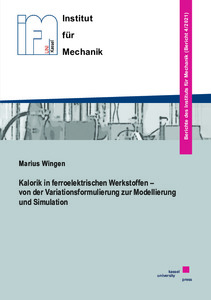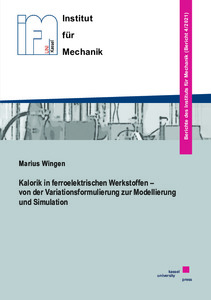| dc.date.accessioned | 2022-01-14T07:38:33Z | |
| dc.date.available | 2022-01-14T07:38:33Z | |
| dc.date.issued | 2021 | |
| dc.identifier | doi:10.17170/kobra-202112145254 | |
| dc.identifier.uri | http://hdl.handle.net/123456789/13517 | |
| dc.description | Zugleich: Dissertation, Universität Kassel, 2021 | |
| dc.language.iso | ger | |
| dc.publisher | kassel university press | |
| dc.rights | Namensnennung 4.0 International | * |
| dc.rights.uri | http://creativecommons.org/licenses/by/4.0/ | * |
| dc.subject | Ferroelektrika | ger |
| dc.subject | Kalorik | ger |
| dc.subject | Thermo-ferroelektrisches Materialverhalten | ger |
| dc.subject | Variationsformulierung | ger |
| dc.subject | Mehrfeldprobleme | ger |
| dc.subject | Modellierung und Simulation | ger |
| dc.subject | Leistungsbilanz | ger |
| dc.subject.ddc | 600 | |
| dc.title | Kalorik in ferroelektrischen Werkstoffen – von der Variationsformulierung zur Modellierung und Simulation | ger |
| dc.type | Buch | |
| dcterms.abstract | Ferroelectric materials are nowadays used in many areas due to their special electro-mechanical properties. Since their material properties are partly strongly dependent on temperature and the temperature can have a decisive influence on the reliability and life time of ferroelectric components, caloric aspects have increasingly been investigated in recent years, not least because the electrocaloric effect is suitable for solid-state refrigeration. The thesis deals with the modeling and simulation of nonlinear thermo-ferroelectric material behavior. The focus is particularly on the modeling of temperature changes due to domain wall motion in the material and its numerical implementation. To establish a corresponding numerical discretization scheme, a weak form has to be derived, which conatins the constitutive and balance equations of dissipative thermo-electro-magneto-mechanical multi-field problems. The method of weighted residuals is usually used for this purpose, since a classical functional of caloric and electrodynamic problems, as a prerequisite for a cariational approach, is not known. Deficiencies lie in the different units, which, in contrast to mechanical stress, electric displacement and magnetic field, intrinsically involve time rates in the fluxes of heat and electrical current. By combining classical variational principles, i.e. Hamilton’s and Jourdain’s principles, and introducing a heat and a charge flux potential, a modified variational principle is introduced and referred to as the principle of Hamilton-Jourdain. Based on the weak formulation, an algebraic system of equations is finally set up and implemented together with the thermo-electro-mechanical constitutive model into a commercial finite element software, which is finally used to numerically solve various boundary value problems. | eng |
| dcterms.accessRights | open access | |
| dcterms.creator | Wingen, Marius | |
| dcterms.dateAccepted | 2021-05-2021 | |
| dcterms.extent | xvi, A5 | |
| dc.contributor.corporatename | Kassel, Universität Kassel, Fachbereich Maschinenbau | |
| dc.contributor.referee | Ricoeur, Andreas (Prof. Dr.) | |
| dc.contributor.referee | Kästner, Markus (Prof. Dr.) | |
| dc.publisher.place | Kassel | |
| dc.relation.isbn | 978-3-7376-1006-3 | |
| dc.subject.swd | Thermodynamik | ger |
| dc.subject.swd | Ferroelektrikum | ger |
| dc.subject.swd | Werkstoff | ger |
| dc.subject.swd | Stoffeigenschaft | ger |
| dc.subject.swd | Leistungsbilanz | ger |
| dc.subject.swd | Mehrfeldproblem | ger |
| dc.subject.swd | Modellierung | ger |
| dc.subject.swd | Simulation | ger |
| dc.type.version | publishedVersion | |
| dcterms.source.series | Berichte des Instituts für Mechanik | |
| dcterms.source.volume | Bericht 4/2021 | |
| kup.iskup | true | |
| kup.price | 39,00 | |
| kup.series | Berichte des Instituts für Mechanik | ger |
| kup.subject | Naturwissenschaft, Technik, Informatik, Medizin | ger |
| kup.typ | Dissertation | |
| kup.institution | FB 15 / Maschinenbau | |
| kup.binding | Softcover | |
| kup.size | DIN A5 | |
| ubks.epflicht | true | |



